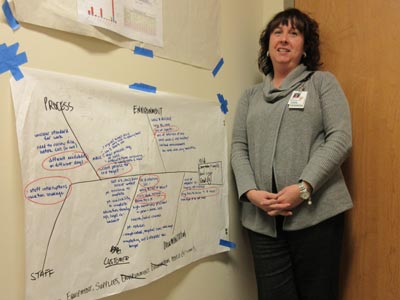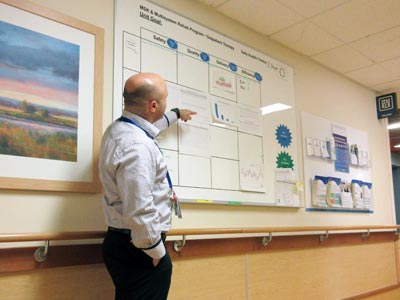
Cathy Irwin and her team use a fishbone diagram to brainstorm likely root causes when they encounter a problem. (Photo: UHN)
Patients at Toronto Rehab are now getting in the door much earlier. And, when it comes to rehabilitation, how soon a patient starts affects their recovery.
You might think reducing wait times comes at a cost – more infrastructure, more staff, more hours. But it turns out it's possible to offer patients care faster by simply making it easier for people to do their work.
The secret is getting rid of the so-called red tape, or the wasteful steps in processes, making the whole system run smoother.
"We're starting to realize that the best, and only, way to solve big, complex problems is to work with the people doing the job to solve the small, simple problems," says Cathy Irwin, manager, Neurology Services Clinic, Toronto Rehab.
Three clinics at Toronto Rehab have shown what it is possible to achieve with process improvement:
- The Stroke Outpatient Rehab Clinic reduced wait times from 15 days to six.
- The Physician Clinic contacts patients one day after a referral, down from an average 117 days.
- Neurology Services clinic patients can start their assessments 18 days after the clinic receives the referral, down from 24.
The managers explain how they did it.

Georgeta Savu and her team adapt to challenges as they arise in order to deliver the best possible patient care. (Photo: UHN)
Georgeta Savu
"Our patients are coming in earlier than they used to," says Georgeta Savu, manager, Stroke Rehab manager, Outpatient Rehab Clinic, Toronto Rehab. "We are maximizing the availability of our clinicians during the times of the day patients most prefer."
Stroke outpatient rehab clinic patients need to see up to three clinicians in one day, three days a week, for at least four weeks. It's a scheduling challenge that the team used to manage by meeting once a week to find a way to fit in all their new patients.
By finding a new way to schedule, the team can now come up with appointments as soon as the referral is received. The team meets for a weekly huddle to discuss wait time, therapy sessions and other key metrics.
"You have to be adaptable," says Georgeta. "In order to make any changes work, you've got to be prepared to measure them, evaluate and make changes when necessary. Most importantly the team knows their goal, and came up with the solutions themselves. It's a significant change and one that was achieved by the team."
William Cachia
Staff in the Physician Clinic at Toronto Rehab eliminated a 117-day delay from their process by reducing the number of steps in the process from 70 to 25 and implementing a visual management system. They now call patients the same day a referral is received. The clinic manager, William Cachia, is applying the lessons he learned from that experience to the outpatient therapy clinic he also manages.
"We know there are opportunities to reduce wait times in this clinic," says William. "Our first step is to understand the flow within the clinic. We need accurate, real-time knowledge of the wait time, and we need to identify the contributing factors before we can set a goal and begin pursuing it.
"The hardest part, which the staff have been great with, is cultivating a change mindset by making it clear to the team that this is about getting better, not pointing fingers."

William Cachia reviews the performance metrics the team uses to determine where they focus. (Photo: UHN)
Cathy Irwin
The Neurology Services clinic provides assessments for people with neurological injuries sustained on the job who are referred by the Workplace Safety and Insurance Board (WSIB). In the past it took an average of 24 days for the clinic team to admit a patient after receiving the referral. In just two months, the team reduced that time to 18 days and patients are now initially contacted four days earlier.
"I was skeptical at first about the value of visual management," says Cathy. "I've been pleasantly surprised at how effectively it's driven change without a lot of effort on our part. We haven't done anything radical, just made it easy to see our performance at a glance, and started daily discussions about problems we're facing."
"Managers are inherently problem solvers," says Cathy. "I've had to learn to pause and reflect on how to get to the root cause of the problem rather than just reactively putting out fires, which doesn't permanently solve the problem and sometimes causes further issues downstream."
